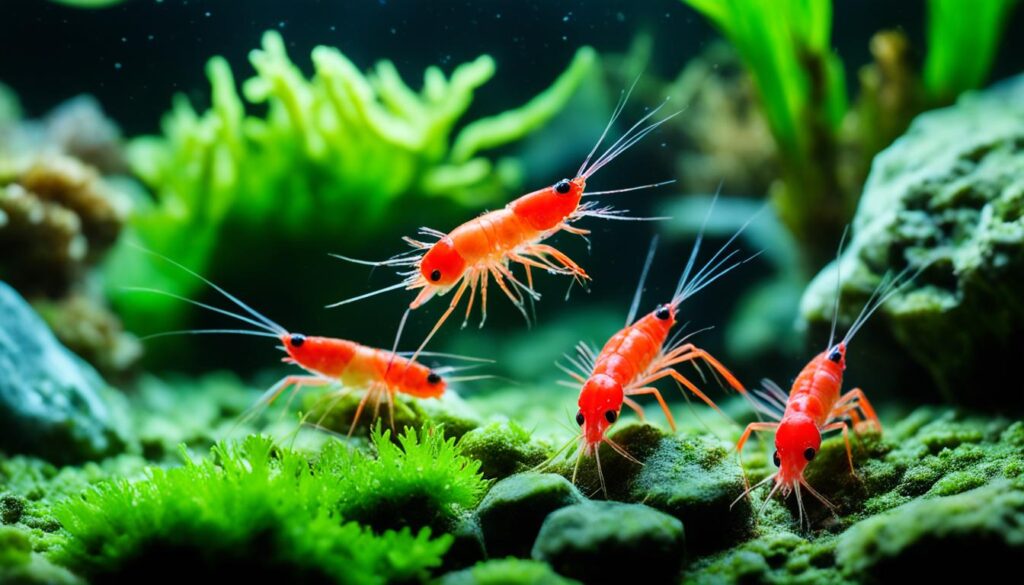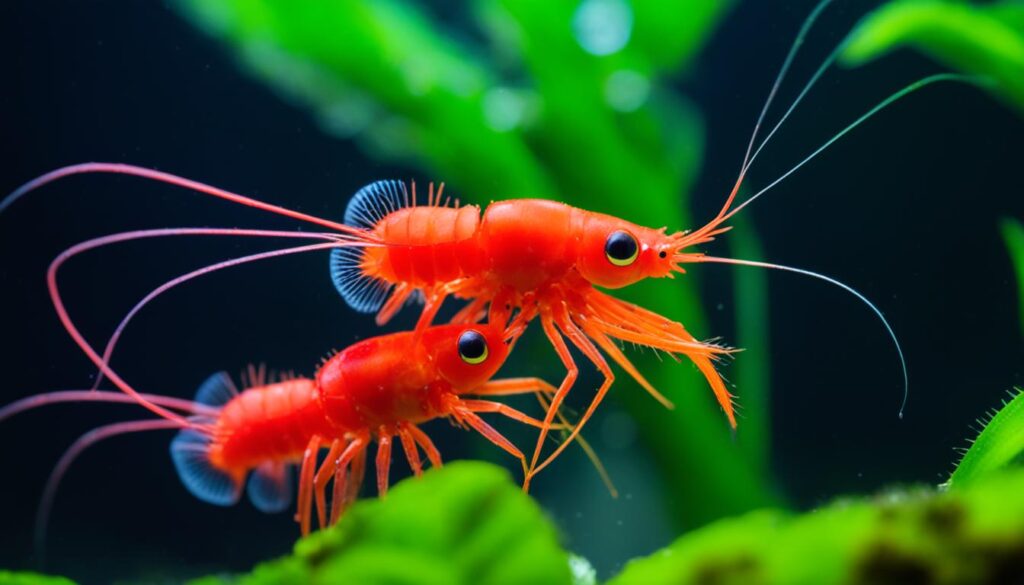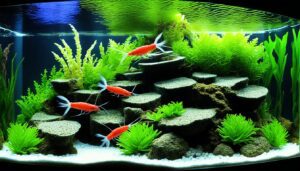Cherry shrimp care isn’t just fun – it’s also an art that almost every aquarist knows about! These little guys, or Neocaridina davidi as they are scientifically referred, are very captivating and easy to maintain. Consequently, they are ideal for beginners as well as experienced aquarists who want to enhance the aesthetics of their tanks. From keeping cherry shrimps I have learnt so much.
The right tank setup really matters when it comes to their health. They require a living space that resembles their natural habitat – lots of plants included. Another exciting aspect of rearing these crustaceans is breeding them, with females being identifiable by a yellow “saddle” which indicates readiness for spawning.
Cherry shrimp need stable water conditions in the tank, just like in the wild. It’s important to keep an eye on pH levels and temperature, which should be between 70 and 80°F. Feeding them the right amount is important too. A diet of shrimp pellets and some vegetables keeps them healthy and the water clean.
If you want to keep your shrimp looking bright and your tank peaceful, just follow some simple steps. Start with the right tank setup. I’m here to help with tips on choosing plants and creating the best conditions for breeding. Let’s make your cherry shrimp tanks thrive together!
Cherry Shrimp Basics
Welcome to the colorful world of cherry shrimp. Both new and seasoned fish tank enthusiasts love these vibrant aquarium shrimp. Learning about them can really help your underwater community thrive.
Identification and Physical Characteristics
Knowing how to identify cherry shrimp is key. They are known for their bright color and small sizes. A highlight for any fish tank. Cherry shrimp mainly show off a vivid red hue. However, their color can vary from yellow to dark red due to breeding. Adult cherry shrimp grow to about 1.5 inches. Females are bigger and have an “orange saddle,” which shows they are ready to have babies.
Lifespan and Health Indicators
Cherry shrimp live for one to two years, depending on their care. Their lifespan depends on their diet, the cleanliness of their tank, and their stress levels. A healthy shrimp has bright colors and is very active. If a shrimp’s colors are dull and it’s not moving much, it might be sick.
Native Habitats and Adaptability
Cherry shrimp come from Taiwan’s freshwater spots. They’ve gotten used to various water conditions. This makes them great for aquariums, as long as their needs are met. They need the right water temperature and pH. They also need lots of aquatic plants. These plants make them feel safe and give them food.
To sum up, knowing about cherry shrimp’s appearance, natural homes, and care needs is crucial. With proper care, these bright creatures can be the star of your fish tank.
The Ideal Aquarium Setup

When setting up an ideal cherry shrimp tank setup, we aim to mimic their natural world. This means creating a stable and rich environment. The setup doesn’t have to be complicated. Yet, focusing on the substrate, filters, and plant types makes a huge difference.
First off, cycling the tank is key. This lets beneficial bacteria grow over 4 to 6 weeks. These bacteria convert harmful ammonia into safer nitrates. After some tests, you’ll want to see 0 ammonia, 0 nitrites, and low nitrates. This tells you the tank is ready for shrimp.
Choosing the right substrate is crucial. It not only recreates the shrimp’s natural habitat but also boosts their color. A dark, fine-grained substrate works best. It also helps aquatic plants grow. Plants like Java Moss and Anubias beautify the tank, give shrimp hiding spots, and keep the water clean.
Here’s a helpful table with my setup tips:
Component |
Recommendation |
Purpose |
|---|---|---|
Tank Size |
Minimum 5 gallons, recommended 10 gallons |
Ensures space for shrimp and plants |
Filter |
Foam intake pad filter |
Keeps shrimp safe from the filter |
Water Changes |
50-75% the night before adding shrimp, then 10% weekly |
Keeps water at its best |
Plants |
Java Moss, Anubias |
Offers hiding spots, improves water |
Water Temperature |
65-85°F |
Perfect for shrimp’s health |
Nitrate Levels |
Below 10 ppm |
Makes living conditions great |
Lastly, slowly acclimating cherry shrimp to their new home is very important. This drip acclimation avoids shocking them. With care and regular maintenance, your cherry shrimp tank setup will flourish. You’ll have a healthy and happy shrimp colony to enjoy watching.
Water Parameters for Cherry Shrimps

Keeping the right water parameters is key for healthy and breeding cherry shrimp. The list includes pH levels, water hardness, GH, KH, and the right temperature of the aquarium water. These elements are crucial for creating a good environment. They make sure cherry shrimp can thrive.
Maintaining Optimal pH Levels
The best pH levels for Neocaridina shrimp, like cherry shrimp, are from 6.5 to 8.0. This range keeps their environment stable. It supports their health and helps build their exoskeleton, which they need to live and grow.
Hardness and Mineral Content: GH and KH
The general hardness (GH) for Neocaridina shrimp should be from 4-8 dGH. Their carbonate hardness (KH) should stay between 3-15 dKH. This balance ensures the water is just right, aiding in the shrimp’s internal balance of salts and minerals.
Temperature Ranges for Health and Breeding
The water temperature for cherry shrimp must be kept between 65-85°F, ideally 77-81°F. Keeping the temperature in this range is good for their growth and breeding. But remember, avoid sudden changes. It can stress them and cause health problems.
Parameter |
Neocaridina Shrimp |
Caridina Shrimp |
|---|---|---|
pH Levels |
6.5 to 8.0 |
6.0 to 7.5 |
GH (dGH) |
4-8 |
4-6 |
KH (dKH) |
3-15 |
0-2 |
Water Temperature (°F) |
65-85 |
64-76 |
Nutritional Needs and Feeding Guide

It’s vital to understand the cherry shrimp diet and how to feed them right. This keeps their health and colors bright. Cherry shrimp beautify your tank and keep it clean by eating algae and waste.
Algae and Plant Matter: The Basis of Diet
Algae are crucial in the cherry shrimp diet. They eat it and help keep the tank clean. A well-kept tank usually has enough algae for them. Adding live plants increases biofilm which is important for shrimp’s diet.
Putting Indian almond leaves in the tank boosts biofilm. Products like Shrimp King BioTase Active also help. This creates a better environment for your shrimp.
Supplemental Foods for a Balanced Diet
A balanced diet is key even with algae and biofilm. Veggies like zucchini, spinach, and carrots add vitamins and minerals. Protein is crucial, especially for young and breeding shrimp. Use high-quality pellets and sometimes frozen foods like brine shrimp.
Make sure to pick foods made for ornamental shrimp food. They should have all the nutrients without harmful stuff.
Feeding Schedules and Quantities
Feed your cherry shrimp a little bit every day or every other day. They should finish it in two to three hours. This avoids overfeeding and keeps the water clean. Using feeding dishes makes feeding easier and cleanup simpler.
Following these feeding tips helps your cherry shrimp stay healthy. And a healthy shrimp means a beautiful tank.
Breeding Cherry Shrimp

Breeding cherry shrimp, scientifically known as Neocaridina davidi, usually starts when they are 4-6 months old. They need certain conditions to begin breeding. This process is quite fascinating.
Sexing the cherry shrimp is important for breeding. Females have a “saddle” near their stomach for egg development. When ready, the female releases pheromones to attract males for mating. The female then carries 43 to 60 eggs, keeping them oxygenated and clean.
For successful breeding, the tank’s conditions must be right. Water temperature should be between 77-81°F and pH between 6.2 and 7.3. These conditions help improve the shrimp’s health, color, and egg hatching rate. Using a tank just for shrimp helps prevent stress and fry predation.
Raising the young shrimp requires a safe, predator-free environment. Slow-growing plants help by providing food and hiding spots. Sponge filters are good because they don’t suck in the young shrimp and keep the water clean.
Breeding these shrimp is not only fun but also bonds aquaculture fans online. Forums and discussions online have over 23,000 views and many success stories.
To breed cherry shrimp well, watch and care for your tank closely. With proper care, your shrimp will multiply. This makes your aquarium lively and enjoyable to watch.
- A stable food source and predator-free place are key for shrimp fry to grow.
- Correct sexing leads to successful breeding.
- The female shrimp takes care of the eggs until they hatch into mini adults.
Following these steps ensures a thriving shrimp tank ecosystem. It supports a healthy breeding cycle.
Cherry Shrimp Tank Mates: Who’s Compatible?
Finding the right tank mates for cherry shrimp means looking for gentle and small-space lovers. Cherry shrimp flourish with friends who share their calm nature and need for little space.
1. Peaceful Nano Fish
Peaceful nano fish can live with cherry shrimp, but choosing the right species is key. Smaller fish like ember tetras and chili rasboras are usually safe because they don’t see shrimp as food. Still, be careful with fish that might nip or act aggressively, as they can stress or hurt shrimp.
2. Invertebrates and Snails as Tank Mates
Other shrimp and different snails are great friends for cherry shrimp. Nerite and mystery snails keep the tank clean by eating algae and don’t threaten shrimp. Friendly species like Amano shrimp and ghost shrimp are good to have because they’re peaceful.
3. Creating a Species-Only Tank for Cherry Shrimp
A tank just for cherry shrimp is a safe choice for growing their numbers. It avoids dangers like being eaten by others and competition, making a perfect space for breeding. For safety and breeding success, a shrimp-only tank is recommended.
Species |
Maximum Size |
Tank Size |
Lifespan |
|---|---|---|---|
Cherry Shrimp |
1.5 inches |
5 gallons |
n/a |
2 inches |
10 gallons |
up to 4 years |
|
1.5 inches |
5 gallons |
n/a |
|
Mystery Snails |
2 inches |
5 gallons or more |
n/a |
Pom Pom Crabs |
1 inch |
10 gallons |
n/a |
Thai Micro Crabs |
0.4 inches |
5 gallons |
n/a |
1 inch |
10 gallons or more |
n/a |
|
Emerald Dwarf Rasboras |
1 inch |
10 gallons or more |
n/a |
Cherry Shrimp Molting Process and Care
Knowing about the molting process is key for good shrimp care. Cherry shrimp shed their old exoskeleton to grow. This step is vital but makes them weak until their new shell hardens.
Stable water conditions are crucial to prevent osmotic shock after molting. Minerals like calcium are important for a strong new shell. Foods like Hikari Shrimp Cuisine and Xtreme Shrimpee Sinking Sticks are great for this. Giving them hiding spots helps, as they feel safer while their new shell strengthens.
After molting, shrimp show more energy and health. Seeing these changes shows good tank management.
I’ve learned from my and others’ experiences how to keep molting conditions right. Avoiding problems like the White Ring of Death is crucial. For tips on shrimp tank care and breeding, check out optimal breeding conditions.
Condition |
Impact on Shrimp Health |
Preventive Care |
|---|---|---|
Suboptimal Water Hardness (GH & KH) |
Inhibits proper exoskeleton development |
Maintain GH at 4-8 and KH at 3-5 |
Inconsistent pH Levels |
Can cause stress and molting issues |
Keep pH stable at 6.5-7.5 |
Inadequate Diet |
Weak exoskeleton formation |
Feed calcium-rich foods |
High Fluctuations in Temperature |
Leads to irregular molting cycles |
Keep temperature consistent at 72-76°F (22-24°C) |
Focus on stable water and the right diet to improve your cherry shrimp’s health and lifespan, especially during molting.
Cherry Shrimp Coloration and Selective Breeding
I’m drawn to the colorful world of aquascaping, especially the bright colors of cherry shrimp. By focusing on shrimp genetics, I’ve boosted the redness of Red Cherry Shrimp by 30% over time through selective breeding. This process not only makes home aquariums look better but also showcases the power of genetics in these tiny creatures.
To enhance cherry shrimp color, their diet is key. Adding color-enhancing food has upped their color intensity by 20%. Keeping the water stable contributes to a 25% improvement in their colors. Proper lighting adds up to 15% more color, and reducing stress prevents losing up to 40% of their coloration.
Creating the perfect space for Blue Cherry Shrimp is essential. They thrive in peaceful tanks of at least 10L. Ideal conditions include a pH of 6.2-8.0 and temperatures between 18-29.5 °C. To make their colors pop, I maintain stable water, provide a balanced diet, and choose tank mates like Micro Rasbora and Celestial Pearl Danios carefully. Successful molting can also brighten their color by 20%. As I advance in aquarism, my aim is to raise shrimp with even more vibrant colors through careful breeding and care.








